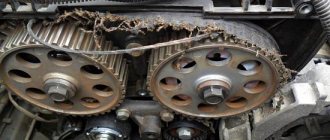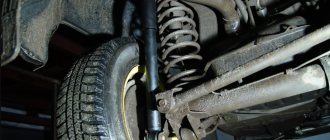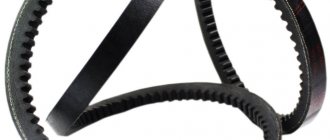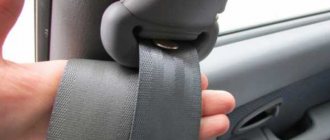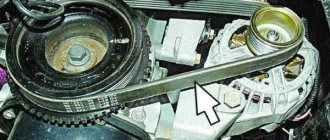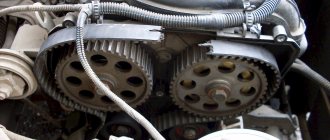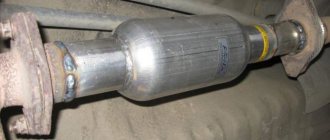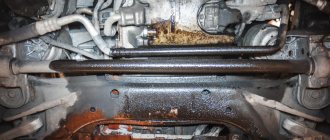26.10.2021
| (Votes: 1, Rating: 5) |
Issues discussed in the material:
- Purpose of the timing belt
- 6 main reasons why the timing belt breaks
- Signs of a broken timing belt
- Consequences of a broken timing belt
- Timing belt replacement interval
- Instructions on what to do if the timing belt breaks
- Reviews from car enthusiasts about timing belt failure
Why the timing belt breaks is a question that haunts many drivers. Replacing this unit is often expensive, and its wear can occur for a variety of different and often simply unknown reasons. Let's say right away: a breakdown usually represents a whole series of factors that were initially overlooked.
Let's tell you more about them. Read about the key points, signs and consequences of a broken belt. You will also find advice on what to do in the event of a breakdown and how often to change the unit. With this information, you will be better savvy and prevent your car from breaking down.
Why does the belt break?
1) Everything is banal and simple. The timing belt is a fairly strong “link” on foreign cars; it can last quite a long time, about 150,000 kilometers. However, everything has a limit! Over such a period of time it simply “wears out”, it becomes thinner and is no longer able to hold tension - that’s why it breaks. This is the most common reason - they simply did not replace it on time. It should be noted that on our VAZs, the belt runs much less, for example, from 30 to 50,000 kilometers. Personally, I had cases when it broke after 15,000 km. That is why the main complaints come from the owners of PRIOR, Kalin and other AvtoVAZ. If you bought our car, and even second-hand, then I advise you to replace the belt immediately! Otherwise there may be problems.
2) Another reason is the failure of the tension rollers. They are designed to tension the belt so that it does not slip or fly off the teeth. Essentially, rollers are bearings with a special layer on top, and as you and I know, bearings also have a service life. Towards the end of operation they begin to make noise and your engine begins to “diesel”. If you don’t change them, they will simply jam, which will literally erase the timing belt “canvas” in just hours.
3) Sometimes a break does not occur, but due to excessive wear, the rubber teeth that mesh with the shaft gears break. It’s also not very pleasant, you look - there is no break - but the car does not start, or it starts, but does not work correctly! The fact is that the ignition is faulty and needs replacement again.
4) On our cars, sometimes the pump jams. It can also wipe the timing belt, see the video below.
5) Well, the last reason is poor quality spare parts. This often happens, again with our VAZs. For example, you came to a service station, replaced the consumables, drove 5000 km, and it “BANG” and broke off. A “burnt part” is death for the engine, no matter what it is. So try to buy such components from trusted service stations, even if from an official dealer, they don’t skimp on the timing belt.
In general, there was an impulse, what next...
Toothed Pulley
There is another common mistake. To set the camshaft marks correctly, many people try to lock the toothed pulleys. There seems to be nothing wrong with this. BUT! If you stop with any metal objects, they may damage the teeth.
Minor scuffs or damage will appear. Which, when working, can literally eat a belt in a few thousand kilometers
What will happen, what consequences await?
You know, sometimes you can get away with it, that is, without suffering any damage. Just install the new one, set up the car and that’s it – let’s move on! But sometimes you end up with very expensive repairs.
When the timing belt breaks, it is mainly the valves that suffer - if we “exaggerate the picture”, it turns out that the upper camshaft does not work due to a break, the valves are frozen in one position, but the crankshaft pushes the piston up - this is where the piston and valve meet , and the weak link suffers - very often the valve bends.
Less often, but again it happens - the camshaft pastel breaks, or the upper part of the piston breaks.
This is a very unfavorable situation, at a minimum you need to change the valves, which means disassembling the engine - buying a new gasket, lapping the valves correctly, etc. ON some foreign cars, repairs reach 30,000 rubles. But if the pastel and pistons are damaged, then it’s even more expensive.
“But wait,” you say, but what about “getting away with it”?
Yes, this also happens - many manufacturers make special recesses in the upper part of the piston. The bottom line is this: when a break occurs, the piston goes up - the valve is in place - but when the piston reaches the top point, it falls into the hole and no “jam” occurs. You just need to put on a new belt, set the marks and start the engine. ALL!
“Just wonderful,” you say. But why shouldn’t all manufacturers do this?
Required Tool
Next, let's look at how to replace the chain and belt on the 2105. First, you need to understand the tools and accessories required to perform this operation; there are not many of them.
To replace the chain drive you will need:
- Open-end and spanner wrenches (10, 13, 17);
- Crankshaft pulley nut wrench (36);
- Flat screwdriver;
- Hammer;
- New chain;
And to replace the belt you will need even fewer tools:
- Open-end and spanner wrenches (10, 13, 30);
- Socket wrench (17);
- New belt;
- Chain replacement
Having all this, you can start working. First, let's look at the chain replacement sequence. To do this, it is better to place the car on an overpass or inspection hole, and put wheel chocks under the wheels.
How to determine a break and what not to do
For an inexperienced motorist, identifying a break is not so easy. Your car will simply stall and will not start.
To begin with, I will say this - if the timing belt breaks, the car will not start under any pretext, because the compression is broken. Beginners often “turn” the engine until the battery is seated, but it does not start - this is not correct! You are only aggravating the situation - the piston, like an “anvil,” hits the already bent valve, and you add more. Should not be doing that!
The second sign is that the engine rotates too easily, if you can identify it, it feels like no one is holding the pistons - of course there is no compression!
Well, and probably the last thing - open the hood and look at the timing system, if possible, sometimes it is closed, if you see pieces of the belt - urgently go to the service station. We call a tow truck.
In conclusion, I would like to add that the entire timing system needs to be changed, and this includes the belt, rollers, and tensioners - a complete set. Then the operation will be stable and safe - your engine will last for many years.
Now a short but useful video.
I hope you liked the article, read our AUTOBLOG, it will be interesting.
( 28 votes, average: 4.68 out of 5)
The gas distribution mechanism/timing mechanism provides control of gas flows in the cylinders of the internal combustion engine, and also switches phases during the gas distribution process. One of the main parts in this mechanism is the belt/blade. It connects the internal combustion engine shafts (camshaft, crankshaft) in a certain sequence and is needed so that when the pistons move (up/down), only the required valves open/close. This creates the pressure inside the cylinders required to ignite the working mixture. The timing belt is an extremely important element in the structure of the power unit. Next we will talk about what causes a broken timing belt. The consequences of a break and their elimination often cost the car owner a pretty penny.
Crankshaft PULLEY wear
As it becomes clear, it is put on the crankshaft (crankshaft) and then rotates two large camshaft pulleys.
So, due to the fact that it rotates at very high speeds, it can actually wear out. According to technical literature, after 120,000 kilometers wear is 0.15 mm in diameter.
Because of this, it will begin to bite the belt teeth, which will lead to rapid wear, literally after 10,000 km
What to do? Yes, just replace it when replacing the entire timing system. Which is done extremely rarely, because dismantling it, simply removing it, is quite problematic. But it is often the reason for the frequent breakage of the belt drive
Timing belt modifications
Since the invention of the car, developers have offered different types of timing belts. At different times, mechanism belts were made from different materials and in different variations:
- leather product;
- metal chain;
- a metalized modification with a rubber base, which is used today on cars of all types and from various manufacturers.
Timing belt
The indisputable advantages of modern timing belts include:
- Ease of use.
- Reliability of the design.
- Acceptable price.
A metal chain is highly expensive and complex in design, and therefore this type of belt is practically not used in budget cars. Leather samples have a short service life and, despite their minimal cost, are not popular among modern motorists.
Symptoms of a broken timing belt
It's no secret that even the most reliable mechanisms break down when they run out of working resources . And the timing belt, which is of great importance and ensures stable operation of the engine, is no exception! Not only professionals, but also ordinary car enthusiasts know that the consequences of a broken timing belt can be very negative, for example, for the vehicle engine.
And in order to identify the problem in a timely manner, you need to know the signs of a broken timing belt. Typically, a broken timing belt is accompanied by a bang, and the power unit stalls, but other elements of the system continue to operate normally. A new engine start in this situation is often accompanied by a “metal” knock and “ease” of rotation of the starter element, due to an incorrect compression process in the cylinders.
When symptoms of a timing belt rupture appear, you need to stop the car, lift the hood and look at its condition.
Although often motorists do not always have the opportunity to stop and check the road surface for integrity, and this often leads to extremely negative results.
Long downtime
The service life of the belt also depends on age due to the tendency of rubber to age. Even with prolonged inactivity, the belt gradually loses reliability.
In addition, conservation or long periods of idleness of the car in the garage negatively affect the condition of the mechanisms. Many moving parts without oil run the risk of souring and will require a lot of energy to turn them. At these moments, the load on the belt increases, and it cannot stand it. It is when starting the engine that belts break most often.
Zero wear. What is the optimal engine speed? More details
Why does the timing belt break?
As stated earlier, the main function of the timing belt is to ensure the operation of the camshaft , which in turn synchronizes the operation of the piston and valve systems of the vehicle. When the belt breaks, this process becomes desynchronized.
Broken timing belt
The reasons for a broken timing belt are different, let’s look at some of them.
Existing limit
Modern timing belts have excellent performance characteristics , including service life. For example, in foreign-made cars it can work flawlessly for up to 150 thousand kilometers. But everything has a limit! Over such a long period of time, it simply “wears out” - its thickness decreases, the ability to maintain the required tension decreases, and other performance characteristics are lost. And that's why the belt breaks.
Wear remains the most common cause of belt damage, so experts recommend periodically checking the belt for wear and, if necessary, replacing it. Note that in Russian Ladas the belt can travel much less than approximately 30-50 thousand km, but sometimes the belt breaks after driving only 15,000. Therefore, complaints are often heard from the owners of Priora, Kalina and other models of this plant.
Advice. If you purchased a Russian car, and even one with mileage (albeit not much), then it would be better to immediately change the belt to avoid problems!
Broken tension rollers
From the names of the parts it is clear that the rollers are intended to provide tension to the timing belt. This prevents it from slipping and jumping off the teeth. In general, a roller is a bearing with a special layer at the top.
Belt Drive Condition Assessment
The average service life of a timing belt is 50-70 thousand km. The exact replacement intervals are indicated in the repair and operating manual for your car. In situations where, after purchasing a car, there is no reliable information about the timing of previous maintenance of the timing drive, the need for urgent replacement can be understood by the following signs:
- Cracks in the belt base.
- Wear of the upper edge of the teeth.
- Oil on the timing belt.
- Noise from the pump, tension or idler pulley.
- Worn belt edges.
Results of timing belt breakage and probable costs
More about the likely consequences
Novice motorists usually ask the question: “What will happen if the timing belt breaks?” The results of fabric rupture, as well as its causes, vary.
How significant they will be depends mainly on the design characteristics - the “simpler” the motor is designed, the lower the likelihood of serious damage!
Typically, a timing belt rupture entails:
- Engine overhaul.
- Repair/complete replacement of the gas distribution mechanism.
- Replacement of valves due to their bending due to incorrect operation of the timing belt. This happens when the valves are lowered, releasing gas/injecting fuel mixture. At this moment, the crankshaft, rotating inertia, hits the piston. It's the pistons that do the heavy lifting. Although, this problem mainly occurs in cars in which the dimensions of the combustion chamber are deliberately reduced, or there is no recess on the surface of the pistons. To determine the level of damage, it is advisable to take the car to a service center, since it may be necessary to dismantle the head and diagnose the motor using special equipment. Ideally, it is necessary to replace the complete valve set, even if the engine was idling when it broke and not all valves were damaged.
- Collapse of participants in the piston system. Usually Japanese cars suffer from this, and this happens due to a significant impact on the heads from the valves. When the blade ruptures at high speeds/high revolutions and the valves “fly”, the bushing bursts and the pistons are punctured by debris. Then there will be an extremely expensive repair with a head change.
The most severe consequences of a break in the gas distribution mechanism are observed in diesel power units. Due to their design features, there are “obstacles” to the movement of the valves, and therefore in the event of a rupture, when the valve is at a dead center, the following can simultaneously happen:
- camshaft failure;
- cylinder head failure;
- deformation of connecting rods;
- the valves will be bent.
Costs for eliminating the results of timing belt rupture
The price of the valve, excluding associated expenses, is approximately 1000 rubles (give or take). It’s quite easy to calculate the cost if you need to change all 16 valves of a modern engine. The cost of such a replacement will be very significant.
In addition, you will need to purchase some “little things”, for example:
- Belt or complete timing gear kit, including all bearings;
- a gasket for each of the manifolds (intake/exhaust);
- cylinder head gaskets and valve plugs;
- fasteners;
- It is possible that you will need to purchase a pump (water pump) when wear is suspected.
In addition, if you plan to carry out the necessary work yourself, you will need the appropriate keys, screwdriver, pins, and sometimes a special tool.
Replacing the timing belt
Procedure for replacing the timing belt
To remove the old timing belt, you must perform the following steps:
- Remove the timing case, which is secured with several bolts.
- Unscrew the fasteners on the crankcase protection.
- Remove the belt from the compressor by dismantling it, remove the belt and return the compressor to its proper place.
- Remove the belt from the generator.
- To de-energize the contacts, you must remove the terminal from the battery.
- Unscrew the fasteners on the engine and remove the generator, terminal and water pump pulley, remembering to first remove the corresponding bolts.
- It is possible that it will be necessary to dismantle the base of the power unit.
- Remove the protection cover from the timing belt.
After completing all these steps, you can make a replacement. To do this, you need to remove the cover from the toothed pulley and remove the torn timing belt. Then you need to install a new blade, not forgetting to tighten the tensioner. If wear is detected on the rollers, they also need to be changed. Then perform the steps described above in reverse order to return the structure to its original state.
Please note! For a specific car model, there are characteristic nuances in removing and installing the timing belt, although in general they are very similar.
We use trusted manufacturers
The better the quality of the part, the longer it will work - this is a kind of axiom. Therefore, take only normal manufacturers, both the belt itself and everything else, rollers, pump and pulleys, if necessary (more on that below).
My advice is to go to an official dealer and buy everything from him. For what? Yes, you just need parts that are installed on the conveyor, so you will have a chance that they will work out the resource declared by the manufacturer.
Or look for famous brands, buy in trusted places (so as not to run into a fake). If you buy something of dubious quality, to put it mildly, then you shouldn’t expect it to work for years.
What does this lead to?
If your timing belt breaks, the consequences can vary. As we said earlier, it all depends on the design of the power unit. Here you can be guided by the principle “the simpler the motor, the more reliable it is.” When the engine is in the TDC position, the valve does not reach the bottom of the piston, nothing will happen. In this case, if the timing belt breaks, only the purchase of a new product can be included in the expense item. All valves will remain intact without damage to the stem geometry.
Incorrect tension
Next comes technical advice; the timing belt can often break due to improper tension. Again, take a 126 motor, it has a tension roller, it must be tightened in a certain position. It has two marks that need to be aligned.
Many overtighten, others don't tighten all the way. All this leads to incorrect operation, it will simply tear or fly off. So the tags were not invented in vain. In general, read the user instructions before replacing.
Causes
There are many factors that cause a break:
- Contact of oils and dirt on the rubber coating. To prevent this from happening, this unit is carefully closed with a plastic case, which is secured with bolts on both sides. When an element breaks or is replaced, this casing is often deformed, which is why foreign objects can re-enter the surface of the mechanism.
- Natural wear and tear of the element or a manufacturing defect.
- Water pump wedge, or in common parlance “pump”. It is closely interconnected with the operation of this mechanism.
- Wedge of tension roller, camshaft or crankshaft. It is very difficult to cause a breakdown of the last two, which cannot be said about the pump or the roller.
Missing protective cover
The belt is protected from external influences by a casing. In most cases, after repeated repairs or accidents, this plastic part is lost or broken when the timing mechanism is disassembled by unqualified craftsmen. As a result, the mechanism is open to water, dust and dirt. Over time, build-ups form on the rollers, which disrupt the contact density of the belt and weaken its engagement. Dust also gets into the bearings, acts as an abrasive and wears them and the belt teeth. As a result, souring bearings increase the load, and the belt can slip through the teeth or break.
Replacement
If the timing belt breaks (whether it’s a VAZ or a foreign car, it doesn’t matter), the first step is to install a new element. There are two reasons for the impending replacement:
- Natural wear and tear. Manufacturers recommend replacing the element at least once every 80 thousand kilometers. However, it is not uncommon for a belt to “nurse” for 150-200 thousand without deformation or whistling. But this does not mean that the replacement can be postponed indefinitely. This can lead to expensive repairs.
- Mechanical damage. The belt structure may be damaged due to gross errors during installation. This is a mismatch of marks, insufficient or excessive tension of the element. Also, the belt breaks (more often than not it simply falls off) during active driving “before the cut-off”, which is accompanied by sharp braking. If the car is “chipped” with a cutoff offset, there is a high probability of a belt break. Therefore, you should not often operate the car under heavy loads.
Soured pump
When installing a new pump, unskilled craftsmen place it at an angle, which affects both the drive and bearings. As a result, the belt works skewed, backlash occurs, and subtle movements of the gear begin relative to the shaft axis. As a result, the belt begins to beat during operation, which also leads to its wear. Extraneous noise from under the hood can warn of a malfunction, which cannot be ignored.
An old pump can throw up other surprises. For example, with severe wear, the pump becomes sour, which causes the drive resistance to increase. The belt cannot cope with the load and breaks.
